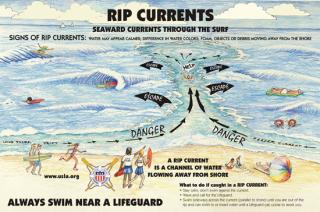Beach & Water Safety Tips

Tragic water accidents happen quickly. The most common reason for aquatic mishaps is a lack of safety knowledge.
Safety Tips
Neptune Beach lifeguards recommend the following safety tips:
- Learn to swim
- Swim near a lifeguard
- Never swim alone
- Supervise children closely, even when lifeguards are present
- Don’t rely on flotation devices, such as rafts, you may lose them in the water
- If caught in a rip current, swim sideways until free, don’t swim against the current’s pull
- Alcohol and swimming don’t mix
- Protect your head, neck, and spine — don’t dive into unfamiliar waters — feet first, first time
- If you are in trouble, call or wave for help
- Swim parallel to shore if you wish to swim longs distances
- Scuba dive only if trained and certified — and within the limits of your training
- No glass containers at the beach — broken glass and bare feet don’t mix
- No beach fires except in designated areas — fire residue and superheated sand can severely burn bare feet — use a barbeque that is elevated off the sand
- Report hazardous conditions to lifeguards or other beach management personnel
- Stay clear of coastal bluffs, they can collapse and cause injury
- Never turn your back to the ocean — you may be swept off coastal bluffs or tide pool areas and into the water by waves that can come without warning
Rip Currents
Rip currents are the most threatening natural hazard along our coast. They pull victims away from the beach. The United States Lifesaving Association has found that 80% of the rescues effected by ocean lifeguards involve saving those caught in rip currents.
A rip current is a seaward moving current that circulates water back to sea after it is pushed ashore by waves. Each wave accumulates water on shore creating seaward pressure. This pressure is released in an area with the least amount of resistance which is usually the deepest point along the ocean floor. Rip currents also exist in areas where the strength of the waves are weakened by objects such as rock jetties, piers, natural reefs, and even large groups of bathers. Rip currents often look like muddy rivers flowing away from shore.
Rip currents are sometimes mistakenly called “rip tides” or “undertows.” These are misnomers. Rip currents are not directly associated with tides and they do not pull people under.
Try to avoid swimming where rip currents are present, but if you become caught in a one, swim parallel to the shore until the pull stops and then swim back to shore. If you are unable to return to the beach, tread water and wave for lifeguard assistance.
Stay at least 100 feet away from piers and jetties. Rip currents often exist along the side of fixed objects in the water.
Be aware of ocean conditions. Lifeguards are trained to identify potential hazards. Ask a lifeguard about the conditions before entering the water.

